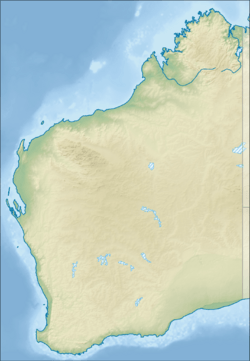Lake Magenta facts for kids
Quick facts for kids Lake Magenta |
|
|---|---|
| Location | Wheatbelt, Western Australia |
| Coordinates | 33°26′28″S 119°11′01″E / 33.44111°S 119.18361°E |
| Type | Salt lake |
| Primary inflows | Lake Lockhart |
| Basin countries | Australia |
| Designation | Lake Magenta Nature Reserve |
| Max. length | 22 km (14 mi) |
| Max. width | 7 km (4.3 mi) |
| Surface area | 110 km2 (42 sq mi) |
| Surface elevation | 390 m (1,280 ft) |
Lake Magenta is a special kind of lake in the Wheatbelt area of Western Australia. It's a salt lake that is also ephemeral, which means it doesn't always have water. Sometimes it's full, and other times it's dry. This makes it a unique place for many plants and animals.
Contents
About Lake Magenta
Lake Magenta is located about 55 kilometers (34 miles) north-east of a town called Jerramungup. It's also about 62 kilometers (39 miles) east of Pingrup. The lake itself is quite large, stretching about 22 kilometers (14 miles) long and 7 kilometers (4 miles) wide. Its total area covers around 110 square kilometers (42 square miles).
A Special Nature Reserve
Lake Magenta is part of the much larger Lake Magenta Nature Reserve. This reserve covers a huge area of 1,080 square kilometers (417 square miles). The bushland to the west of the lake is also included in this protected area.
This reserve is very important because it's still in a nearly natural state. It's home to a wide variety of flora (plants) and fauna (animals). Many different species live here, making it a great place for wildlife.
Challenges for the Lake
Even though the reserve is protected, there are some challenges. The water quality in the area has started to get worse. Also, the health of the plants is declining. This is happening because the amount of salt in the water that runs off the land has increased. The levels of groundwater (water found underground) have also risen. These changes can make it harder for some plants and animals to survive.
The Chain of Lakes
Lake Magenta isn't alone; it's connected to a long chain of other lakes. To its south, there's a wetland area. The lake is also at the southern end of an 80-kilometer (50-mile) chain of lakes. This chain stretches all the way from Lake Biddy in the north. It includes Lake Stubbs, the town of Newdegate, Lake Buchan, and Lake Lockhart.
There are also three other lakes nearby to the east. These are Lake Morris, Lake Royston, and Lake Cobham. All these lakes together form an important natural system in the region.
The Lake's Landscape
Lake Magenta sits in a wide, flat valley. It has long, ancient riverbeds (called paleo-drainages) to the north. To the south, there are more steeply cut drainage lines. The soil around the lake is a mix of sandy and chalky loam. This type of soil is not very developed. Other parts of the area have hard, sandy, and alkaline (meaning it has a high pH) yellow and mottled sands.


